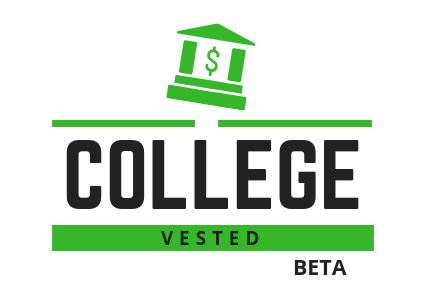
Private Student Loans
CollegeVested’s Comprehensive Guide to Private Student Loans
Written by Brooks Lockett
You’re sitting on your dorm room bed trying to figure out how to complete a FAFSA form. You just maxed out your credit card on textbooks, shampoo and dollar lean-cuisines. Yuck. Then you come to the tough realization that you need student loans to afford college.
You’re not alone. Actually, you’re right there with most people since around 70% of college students take out loans, according to Citizens Financial Group. The next step financial experts recommend is to research the best available options. Private student loans to the rescue!
Keep Reading for CollegeVested’s Comprehensive Guide to Private Student Loans:
What is a private student loan?
Similar to a traditional bank loan, a private student loan is an education loan not funded or regulated by the U.S. Department of Education. You’ll need them once you’ve exhausted every federal loan, grant and scholarship option. Students usually apply for private student loans once all other funding options have been attempted.
“It is usually recommended that the student borrower exhaust all available federal student aid options before they pursue private student loans since there is much less available repayment assistance once the borrower enters repayment,” said student loan consultant Jan Miller.
You’re top priority? Utilizing the best federal options with forgiveness plans since private student loans don’t qualify for federal repayment. Finessing a forgiveness plan on your private student loan will be a good move. Depending on your financial situation, you might even qualify for full financial forgiveness. Or if you work over 30 hours per week while taking classes, you could be eligible for Public Sector Student Loan Forgiveness. Many more programs like this exist.
Students typically use them as a supplement to federal loans and scholarships. One more time to be crystal clear: research, research and research some more your federal aid options.
“I used all the grants and scholarships I could get so I didn’t have to borrow as much from private loans,” said Florida State senior Shawn Blaisedelle.
How do I apply for private student loans?
Luckily you don’t have to meet any deadlines to apply for a private student loan. That way you can take time to research schools’ financing options before applying. Also, you can apply at any time during the year. So if you wreck your bank account from a car crash mid-semester, you can angrily but reassuringly apply for a private student loan.
“The application will resemble a traditional bank loan application, and generally requires a cosigner since students are often not working or generating income,” said Miller.
Just because private loans don’t have deadlines, you shouldn’t slack off on your research because the approval process could take time depending on which lender you choose.
“When you complete your application, be prepared with information about the school you’re attending and the amount you want to borrow,” said personal finance writer Christy Rakoczy. “Your financial aid award letter will help you determine how much money you need from a private loan.”
What are the chances I receive one?
Your calculations tell you that you need to apply for a private student loan. But you don’t even know the eligibility requirements yet. You should carefully consider a few standard factors typically taken into consideration by private lenders.
- Your (or your cosigners) credit score
- Your income
- Your debt-to-income ratio (how much you owe in monthly debt payments divided by your gross monthly income)
- Your cosigner support
“Typically the lender will require a cosigner if the borrower has insufficient credit history or low income,” said student loan lawyer Adam Misnky.
As an undergrad, you’re most likely not going to get a private student loan without a cosigner. Because, well, lenders give in to the stigma that the millennial generation spends money on dumb things. They’re not completely wrong. Also, because good credit scores and stable income require you to have steady employment and a dope credit history, which full-time students don’t have. So by default, you have to fall back on your cosigner’s financial background to be eligible.
Even if you don’t have a good cosigner option, don’t go in panic mode yet. You can still qualify for one even if your cosigner’s credit sucks—but your interest rates might be higher depending on the lender. Just bear in mind that your cosigner acts as insurance for the lender if for some crazy reason you can’t pay. So the responsibility falls on you to understand the repayment terms before accepting the loan. Imagine you owe $400 to a friend from a lost bet, but you make your pushover best friend pay it because you spent all your money on tickets to the new Ted Bundy movie. Don’t be that person.
How do I pay them back?
Private loans don’t work the same way as federal loans. You don’t have to start paying back a federal loan until you’ve graduated or dropped below half-time enrollment. Some private loans might work similarly, but you need to know how the repayment works before committing.
“One way to make student loan repayment easier for those who have both federal and private debt is to use the significant repayment options available to federal loans and leverage them against their private loan payment,” said Miller. “This will make the private debt easier to prioritize and pay back.”
Here are the most common repayment options for private student loans:
Immediate repayment
This option might be unrealistic for most students since not having income in college made them take out a loan in the first place. But if you want to pay back the loan as quickly as possible and drop the weight off your shoulders, this might be a good option. You start making principal and interest payments while still in college. A principal payment is the actual amount you borrow. The interest payment gets tacked on top of it in increments. If you borrowed $3,000 for college, you’re going to have to pay back the $3,000 plus whatever interest the lender agrees to. Some lenders even lower your interest rates in you choose immediate repayment, which could be a good incentive to choose this option. I’m not a finance whiz, but less interest ultimately means more money for me, right?
“Sometimes the best option is to make paying down the student loan your earliest and highest priority before entering the job market,” said debt defense attorney David Addleton.
Deferred repayment
This plan works much like a federal loan. The good news: you don’t have to make payments while still in school. The bad news: your interest accrues during this time period, so you’re going to end up paying more in the long run. But if you’d rather study instead of work and ace all your classes like an academic superstar, then by all means defer your student loan payments until you land your dream job after graduation.
“I am just focusing on school and building my savings before I graduate so I can devote more time and money to repayment when I am done,” said UCF junior Anna Myers.
Interest-only repayment
You only pay back the interest while in college and start making the principal payments after you graduate or drop below half-time enrollment. This way, you make sure your interest isn’t mounting while you’re in school. You won’t owe as much money after graduation since you’re only making the principal payments. A job as a waiter or waitress could cover your interest. Or you could get more creative and start a local soap-making business—just a suggestion. Many lenders will also lower your interest rates if you choose this option.
Fixed Repayment
With this one, the lender sets a predetermined amount you’ll pay every month while in school. After you graduate the lender will adjust the monthly amount to one that includes paying back the principal and interest. Monthly payments will be more affordable overall than interest-only or immediate repayments but won’t make as much of a dent in your total debt.
P.S. the harsh truth is that the typical timeline to repay a private student loan can range anywhere from five to 20 years. So be sure to take all of these facts into consideration before jumping into any sort of repayment plan.
“The best student loan repayment solutions vary widely depending on the borrower’s income, income growth, type of debt and financial objectives. As a result, any one-size fits all recommendation can automatically be presumed to be false,” said Miller.
I know all of this information sounds overwhelming but knowing all this will save you hard-earned money in the long run. Remember: first exhaust all your federal and scholarship options before even your first Google search for private lenders. Then determine who your cosigner will be and see their credit score. Finally, be thorough in your research for the best repayment plan. Last but not least: remember that you’re a brilliant and resilient college student and you will conquer these dreaded student loans. You got this.
